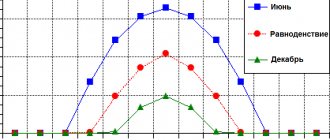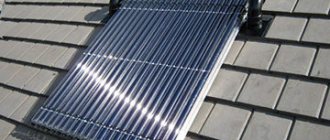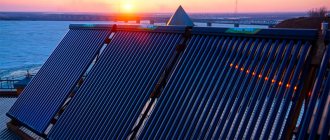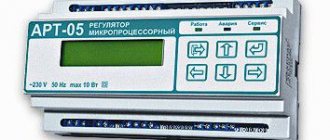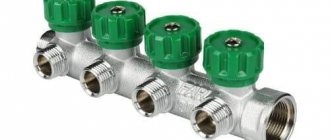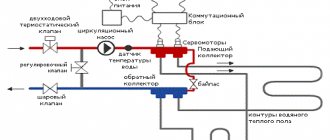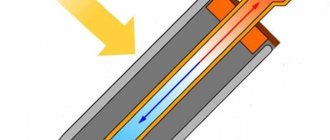Advantages of solar collectors and solar systems from Oventrop
Economical.
Solar collectors significantly reduce the cost of hot water supply and heating the cottage during the cold season. The use of solar power plants reduces the annual cost of heating water by up to 60%, and the cost of heating a building by up to 30%;
Ecological cleanliness.
The solar collector is absolutely safe, because... does not pollute the environment and does not have a negative impact on human health. In addition, in water exposed to high temperatures and vacuum, the appearance and spread of bacteria becomes impossible;
Long service life.
The reliability and durability of Oventrop solar collectors is due to the use of modern high-quality materials. The glass and metal elements of the solar installation are impact-resistant and resistant to sudden changes in weather, in particular gusts of wind;
Autonomy.
A solar system can heat buildings even in the event of long-term interruptions in the heating system. A similar situation occurs when hot water is turned off.
Application specifics
Unlike heat generators and heat pumps, which convert energy from groundwater and air masses warmed by the sun, solar collectors operate from direct sunlight acting on their surface. The only nuance of solar collectors is that at night they are in passive mode.
The daily performance of a solar installation is influenced by factors such as:
- Length of daylight , which in turn depends on the geographic latitude of the region and the time of year. So, for example, in the central part of Russia, the solar collector will function at its maximum in summer, and at its minimum in winter. This is due not only to the length of the day, but also to the change in the angle of incidence of sunlight on the solar panels;
- Climatic features of the region. As a rule, on the territory of our country there are many areas over which for more than 200 days a year the sun is hidden behind layers of clouds or behind a veil of fog. Despite the fact that the solar collector can capture even scattered sunlight, in cloudy weather its productivity is significantly reduced.
Operating principle and device features
The main element of the solar collector is the adsorber. It consists of a copper plate with a pipe attached to it. When absorbing the energy of direct sunlight acting on the solar system, the adsorbing element instantly heats up, transferring heat to the coolant circulating through the pipeline.
The type of surface of the collector determines its ability to reflect or absorb solar rays. For example, a device with a mirror surface perfectly reflects light and heat, while a black plate completely absorbs it. Consequently, for maximum efficiency, the copper plate of the adsorber is most often coated with black paint.
To also increase the amount of thermal energy emitted from the sun, it is necessary to wisely choose the glass covering the adsorber. For solar collectors, special glass with anti-reflective coating and a minimum percentage of iron contained in it is used. Such glass differs from ordinary glass not only in the reduced proportion of reflected light, but also increases transparency.
In addition, to prevent contamination of the glass, which also reduces the efficiency of the solar installation, the collector body is completely sealed or filled with inert gas.
At the same time, the adsorber plate releases part of the received thermal energy into the environment, heating the air interacting with the solar system. To reduce heat loss, the adsorbent element should be insulated. The search for the most effective methods of thermal insulation has led to the emergence of many types of solar collectors. Some of the common types are flat and tubular, or vacuum.
Flat solar collectors: device
A flat-type solar collector consists of an aluminum box, on top of which a protective glass with an absorption layer is installed. Inside the housing there are copper tubes, inlet and outlet pipes. The bottom and walls of the box are protected by the most reliable heat-insulating element - mineral wool.
Some models of flat-plate collectors may also have a layer of propylene glycol under the glass, which acts as a solar absorber. This increases its efficiency, providing the equipment with maximum performance regardless of the season.
Advantages and disadvantages of flat solar collectors
The main advantages of flat solar collectors include:
- The ability to self-clean in the event of precipitation in the form of snow or frost;
- High indicators in the price/quality ratio, which is typical for southern regions with a warm climate;
- High efficiency when operating in the summer season;
- Relatively low cost in contrast to other solar structures.
The main disadvantages of such systems are:
- High heat losses due to the design features of the installations;
- Low efficiency when operating in autumn and winter;
- Difficulties during transportation and installation of solar systems;
- Maximum costs in case of repair work;
- Increased windage of the solar installation.
Scope of application of flat solar collectors
Despite the disadvantages, this type of solar system is used for seasonal heating of hot water. Flat solar collectors are used:
- For hot water supply for summer showers;
- To heat the water in the pool to the desired temperature;
- For heating greenhouses.
Connection diagram for a solar collector in the warm season.
The simplest collector connection diagram includes the following components:
— the collector itself;
— heat exchange circuit;
— thermal accumulator (tank containing heated water).
The flat-plate solar collector has the simplest design and is ideal for use in hot climates with a lot of sunny days and an appropriate level of insolation. It consists of an absorber layer covered with glass, which converts and transfers thermal energy to the coolant (the latter circulates in tubes - the thermal circuit).
In regions with cold climates, it is more effective to use a vacuum collector, the design feature of which is the use of vacuum tubes for heating. Glass tubes, due to their cylindrical shape, are able to capture the sun's rays for a longer period of time (it is better to use a sunny day), and the selective coating used in their design captures even scattered solar radiation. Thanks to this, they are more efficient when installed in most regions of our huge country.
In the summer, when solar insolation reaches its peak, the operation of the solar collector gives tangible results, regardless of which solar collector is used - flat or vacuum.
At this time of year, you can safely use water as a coolant (this also applies to regions with “mild” winters), which is heated by the energy received from the absorber and rises up through the pipes, entering the storage tank. The tank is connected to water outlet taps, so when the valve is opened, hot water leaves the tank and is replaced by cold water. Water of lower temperature accumulates at the bottom of the tank and exits into the system circuit through the corresponding pipe. It is heated again from the energy received and enters the tank. In the storage tank itself, the intake pipe through which hot water is supplied for use should be located at the top of the tank (due to its lower density, warm water rises upward).
This water storage tank can be placed both outdoors and indoors. The most common and simplest option in the first case is a water shower. The tank, painted black, attracts heat on its own and warms the water even more. To avoid heat loss at night, the tank must be insulated.
This simplest solar collector connection scheme provides only natural (and not always sufficient) coolant circulation. You can increase the productivity of the system using a circulation pump.
Vacuum solar collectors
A vacuum solar collector is a high-tech complex device designed to collect thermal solar energy and its subsequent processing into thermal energy, which is used in everyday life and industrial applications to provide heating and water heating in water supply systems. The solar vacuum collector is highly efficient and ergonomic, has high efficiency even in low light conditions and low temperatures, which makes it possible to use the system at any time of the year. The device allows you to convert infrared radiation penetrating through clouds and scattered rays into heat. Oventrop solar collectors are capable of heating water up to one hundred degrees Celsius even at subzero ambient temperatures.
How does a collector work in a heating system?
Most often, solar systems use ordinary water, as well as antifreeze, for their operation. If the water temperature in the lower part is lower than in the collector, the heating is turned on. Water moves through the system thanks to a built-in pump. The water in the storage tank is heated through a heat exchanger ; usually the collectors are heated only to a certain temperature.
If necessary, the direction of water in the system changes thanks to the mixer. Thus, cooling and warm water replace each other from time to time. Due to the expansion of warm water, fluid is replaced in systems with natural circulation. When heated, warm water rises, cold water is pushed into the heating tank.
It is necessary to have a thermal insulation layer at least 25-30 centimeters , otherwise the system will not be able to operate stably. As for the tank, it is best to use a rectangular shape. If this condition is met, the water will be evenly distributed over all available areas. So the operation of the system as a whole will become more complete.
Scope of application of vacuum solar collectors
The use of the design significantly reduces heating costs in the winter and guarantees free water heating in the summer. The solar collector actively absorbs solar energy and captures 98% of the energy when the vacuum degree is 10-. The systems are installed on facades, flat or pitched roofs. When located in arbitrary places, the angle of inclination should be in the range of 15-750. Service life is at least twenty years.
The systems are widely used for:
- heating water in domestic and industrial water supply systems, swimming pools;
- operation of individual heating systems;
- heating greenhouses.
Collectors are easily connected to water and heat supply networks. To connect the system, a Regusol X Duo station with a built-in heat exchanger and controller is used, which, thanks to the layer-by-layer accumulation of coolant, increases the efficiency of the entire energy system.
Myth one: flat-plate collectors are stronger than vacuum ones
High-quality flat-plate collectors made in Germany are quite durable and can easily withstand hail and similar external influences. But, of course, you can break them if you want. The same can be said about quality vacuum manifolds. In practice, replacing glass tubes with installed vacuum manifolds is quite rare, since quality tubes are very durable and designed to last a long time. Pay attention to the video below, which shows a vacuum tube being tested for strength with a piece of ice, simulating hail. This is a case in point.
And here is the same example using a steel ball.
It is also worth remembering that if a flat plate collector becomes damaged, it usually needs to be replaced, which is an expensive and difficult task. If several glass tubes of the vacuum manifold are damaged, it will still continue to work, and the tubes can be replaced later. Typically, when installing vacuum manifolds, provision is made for how the tubes will be replaced if they are damaged and have reached the end of their normal service life (15 years).
Solar collector installation
The efficiency of the design directly depends on the correct installation of the collector. To avoid the risk of pressure increase due to water overheating, solar collector calculations are performed exclusively in special programs. Calculations are made taking into account weather conditions at the point where the collector is located and the average annual heat consumption. The power of the solar corrector is calculated based on the area data, the insolation value of the system and the efficiency of the collector.
Before starting calculations, it is determined whether the system will be year-round or seasonal.
- Seasonal solar correctors are intended for use during the warm period of the year (mid-April - mid-October). This design consists of a storage tank and a collector. The coolant is water, which freezes at subzero temperatures, so its use in the cold part of the year is impossible.
- Year-round systems can be used effectively regardless of the ambient temperature. The design uses non-freezing ethereal liquid, which ensures high efficiency of the solar collector even on the coldest days of the year.
Vacuum solar collectors, with proper installation and installation, cover up to 60% of the average family in hot water and provide heating from the second half of spring to mid-autumn. For example, when installing a system in the middle latitudes of Russia, a collector with an area of two square meters provides daily heating of one hundred liters of water to 40-600.
The efficiency of the installation in the summer is much higher. In one clear day, 1 m2 of collector will warm up about eighty liters of water to a temperature of + 650. The average annual productivity of a solar collector with an absorbing area of 3 m2 will be in the range of 500-700 kW/h per 1 m2.
Vacuum heating systems
For all their simplicity, reliability and low cost, flat solar storage devices have relatively good heat productivity only on a sunny day. For higher latitudes or early spring - late autumn, its heat output drops by half.
Vacuum systems have higher efficiency compared to flat solar collectors. The design is based on an individual thermal element - a vacuum tube; the operating principle of such a solar collector is based on a device known in physics - a heat pipe, which is quite complex and capricious, but effective in operation. A special feature of the design is ultra-high thermal conductivity, thanks to which all the heat that reaches one end of the tube is collected and concentrated at the opposite end in a matter of moments.
The vacuum element is an elongated flask-tube made of durable glass, the inside of which is sprayed with a mirror coating. Thanks to the one-way mirror, the solar energy flux freely penetrates inside the flask and cannot escape back; it is effectively absorbed by the copper end of the heat pipe placed inside the flask body. To reduce losses, the air from the glass flask is evacuated. The central copper element transfers the energy received from the light flux to the coolant flow, usually antifreeze, or directly to the water tank.
Advantages of vacuum solar collectors
Advantages of converting solar energy with a heat pipe:
- The efficiency of absorption and conversion of solar heat is 3-4 times higher than flat and air collectors;
- Works great in the temperature range of 0-50°C, while other types of solar collectors, according to user reviews, have an operating range of 20°C;
- Lowest sensitivity to the direction and angle of incidence of sunlight. For normal operation of a solar collector, it is enough to be illuminated by the sun, even at an acute angle of incidence of the sun's rays; for other solar collector designs, when the optimal illumination angle goes beyond the optimal illumination angle by more than 20 degrees, the efficiency drops by 10% per hour.
- The low weight of the solar storage structure allows it to be installed directly on the roof, even without a special load-bearing support.
Important! The glass of the flask, in theory, can withstand even hail with a diameter of 2-2.5 cm, perfectly tolerates multi-cycle heating and cooling, and is resistant to any environmental influences and sunlight. But to remove dust from the surface of the glass, it is better to wash it in the evening using warm, clean water.
When planning a purchase, it is worth taking an approximate calculation of the area of the solar collector, based on the ratio: a square meter will provide approximately 50-55 liters of hot water per day, but not boiling water. More accurate information can be found on the websites of companies involved in the production of solar collectors. There you can also get information about the cost of products. Each company proves the super-efficiency and low cost of its products. A vacuum device of 15 elements will cost approximately 15-20 thousand. rubles for a heating power of 1.3-1.5 kW and a storage tank of 80-100 liters.
Interesting features of such solar collector systems include the ability to check the performance of each vacuum flask independently, without any special tools. It is enough in the evening, when not working, to place your palm on the lower end of the pipe. If the element remains cold for a long time and there is no frost-like deposit in the sealing area of the flask, the device is considered to be in good working order.
Hot water from the tank can be supplied by gravity, but most often a low-power booster pump is installed to quickly fill the tank after the hot water is used up. In more serious design options, the solar collector is combined with a heat accumulator and an electronic system for monitoring and controlling hot water supply and heating. The cost of such systems is no less than 1000EUR. Warranties for heat pipe systems typically range from 5 to 25 years, depending on the quality level of the materials used in the device.
Construction of a vacuum solar collector
Oventrop offers vacuum solar collectors with heat pipes. Systems with a heat pipe are structurally reminiscent of a thermos: a glass/metal tube of larger diameter is inserted into another one of smaller diameter. The space between them is evacuated, which ensures the most effective thermal insulation from the effects of external temperatures and minimal losses due to radiation. The vacuum layer allows you to save up to 95% of the absorbed thermal energy.
All evacuated tubes are equipped inside with copper absorber plates with a heliotitanium coating that effectively collects solar energy. A heat pipe filled with a special ethereal liquid is installed under the absorber and connected to a condenser located in the heat exchanger. The solar energy received by the absorber turns the liquid into vapor, which rises into the condenser and gives off heat to the collector, condenses and returns to the lower part of the flask. Thanks to cyclicity, a continuous heat exchange process is created.
The system is capable of generating significant temperatures and provides high efficiency even in low light conditions and temperatures of -30 - -450C (depending on the type of collector with glass or metal tubes). Vacuum solar collectors are simple and inexpensive to operate. Special design connections allow tubes to be replaced or rotated in a filled, pressurized installation.
Types and differences of solar collectors
Today, two types of systems are widespread among industrially manufactured solar collectors:
- flat solar panels;
- vacuum (evacuated) tubular collectors.
Flat solar panel
It is a common type of solar collector used in modern solar energy systems. This type has become widespread due to its relative cheapness and simplicity of both design and operation. The disadvantage of flat solar collectors is a significant (up to two times) decrease in efficiency in conditions of negative outdoor temperatures.
Design of a flat solar collector.
Structurally, it is a panel with an absorbing surface area of 2-2.5 m2, made of aluminum or steel alloys. The front part is made in the form of a sheet of special solar glass, which ensures maximum absorption of solar energy and minimal energy loss from reflected and scattered rays. Directly under the solar glass there is an absorber made in the form of a flat tube made of copper or aluminum alloys with a high heat transfer coefficient.
The tube, as a rule, has radial fins, which significantly increases the heat transfer coefficient of the absorber. A coating with a high absorption coefficient in the thermal radiation spectra is applied to the absorber, which increases the overall efficiency of the collector. Under the absorber there is a layer of thermal insulation, which reduces heat losses from the system to the environment. The required thermal power of a solar collector is achieved by incorporating several panels into a single solar battery or collector.
Vacuum (evacuated) tubular manifold
An expensive type of solar collector due to complex manufacturing and a number of advantages over flat solar panels. Structurally, it consists of a series of paired glass pipes soldered together, with air evacuated from the space between them. The vacuum in the space between the tubes is an excellent thermal insulator and prevents heat loss to the environment from the coolant. A copper, aluminum or glass absorber tube is inserted into the smaller pipe. The top part of the pipes is inserted into the distributor in which the coolant circulates. Vacuum (evacuated) tubular collectors according to the type of distributor are divided into two types: with a flat heat pipe and direct-flow.
Flat tube manifolds
Vacuum tubular solar collector with flat heat pipe - design.
They are a recuperative heat exchanger located in the distributor. In this case, heat transfer from the heated coolant of the vacuum pipe to the coolant of the heating circulation circuit of the building occurs through the wall and the coolants of these circuits do not mix. The advantages over direct-flow collectors include maintaining high performance at ambient temperatures down to -45 ° C, the ability to replace a separate vacuum tube that has failed without disassembling the collector and stopping its operation, as well as the ability to adjust the installation angle of each vacuum tube within one collector .
Direct flow collectors
Direct-flow vacuum tubular solar collector - design.
They combine the circulation and heating circuit. The distributor contains supply and circulation pipelines, to which vacuum tubes are directly connected. The coolant is supplied to the distributor through the supply pipeline, from which it enters the vacuum tube, where heating takes place. The heated coolant is returned to the return pipeline and goes directly to heat supply needs. The advantages of direct-flow collectors over vacuum ones are the absence of an intermediate wall between the coolants, which reduces heat losses and the ability to install the collector on any surface at any angle, since the circulation of the coolant within the entire collector will be carried out by a pump.
